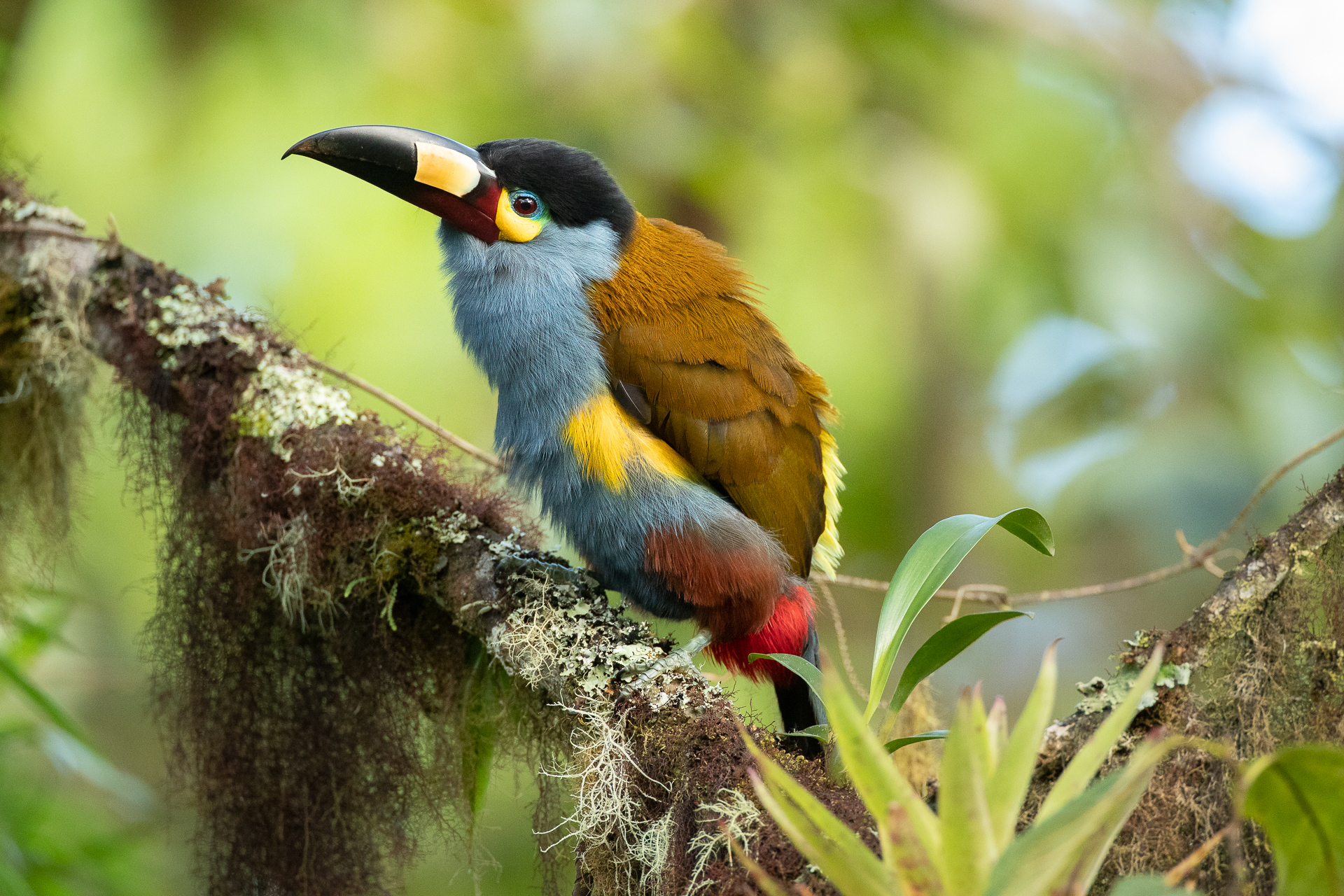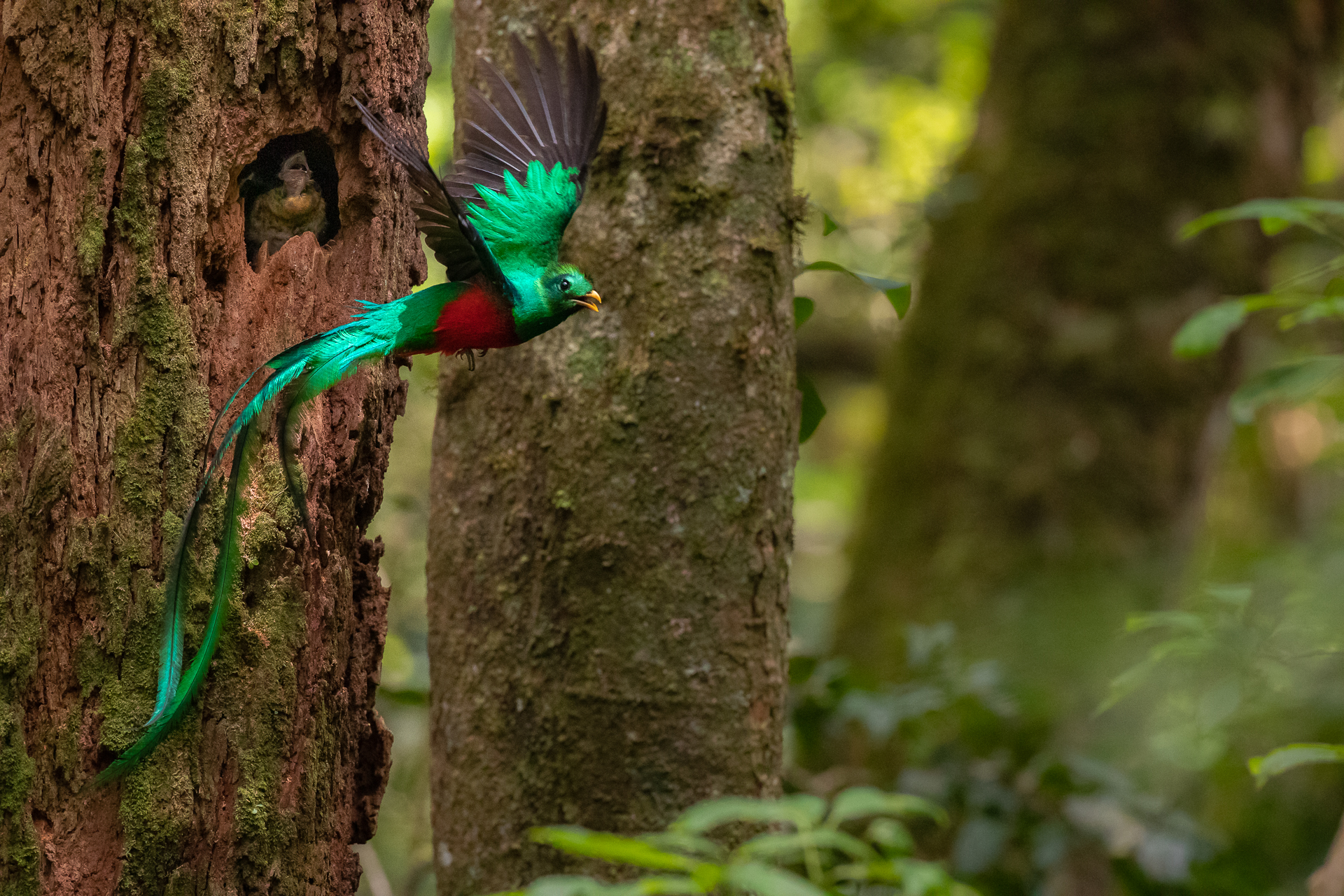The Plate-billed Mountain Toucan lives only in the west Andean slopes of Ecuador and a very small portion of Colombia. They are listed as near threatened on the IUCN red list since their range is fairly restricted, and they are victims of habitat loss and illegal pet trade.
Sword-billed Hummingbird
Here is another one of Ecuador’s 132 hummingbirds, the sword-billed; the only bird with a beak longer than its entire body! When perched, they rest with their head upright in order to balance. All of this sounds rather inconvenient right? Well maybe so, but it also provides the distinct advantage of having access to nectar from elongated flowers that the other hummingbirds cannot reach.
Long-tailed Sylph
Ecuador is home to 132 of the 300 different hummingbird species in the world. This short-billed, long-tailed hummingbird lives in the montane forest of Andes.
Quetzal Nest
It’s no wonder that this bird, with its green crest, blood red chest, and 3 foot long iridescent tail feathers, plays a significant role in Mesoamerican mythology. I watched as the male (pictured here) and female took turns feeding their two chicks days before fledging.
Andean Bear of Ecuador
An Andean bear eating puya (the plant depicted below) high in páramo. The Andean bear is the only bear species in South America, and many people, even in South America, don’t even know it exists. The accelerated rate of habitat loss and fragmentation poses a significant threat to these bears, which are listed as threatened across their range, and endangered in Ecuador. The terrain they inhabit, either the rugged high elevation páramo, or the incredibly dense cloud forest, make research efforts difficult, and so relatively little is know about this species at this time.
Santiago, a biologist with a career focus on Ecuadors endangered Andean bear, examines the remains of a freshly eaten puya. Puya, a large bromeliad, is the food of choice for the bears that live up here in the paramo at 12,000 feet.
As a park ranger, Pancho spends day after day sage-guarding these remote and rugged highlands on horseback. While the páramo is critical habit for Andean bears, it also is vital for Ecuadors long term water supply. These highlands function as a sponge of sorts, absorbing and retaining rain water, and then distributing it consistently throughout the lower elevations. As it turns out, preserving the Andean bear and its habitat is very much in the best interest of the local communities.
Andean Cock-of-the-Rock
The Andean Cock-of-the-Rock certainly is one of the strangest looking birds on the planet, and it has been high on my list to see.
I set up my camera on this lek, tucked in the forest on a small point jutting out over the confluence of two rivers, and waited. I could just barely see two males with bright red head through the trees, and suddenly a female flew by and out of sight. This changed the game. Suddenly, I could see and hear 8 males energetically bowing, strutting, jumping, and flapping their wings, all in an eager attempt to win her attention
Costa Rica
Often the best moments arrive in between destinations.
As we were racing down country roads in a hurry to get to a river where we planned to photograph, we rounded a corner to this scene. I had time for one frame, before the dog hopped up and trotted off. It’s one of my favorite moments from the past month in Central and South America, and a good reminder for me to that it always pays to be present and aware.
Shadow Show
One of the most striking shadow displays I’ve ever seen took place as this storm moved over the Teton range.
Great Grey Owl
Sightings of the Phantom of the North have been rare in the ecosystem over the past few years, as the population is at a low point. So having the opportunity to sit with friends, and this male Great Grey as he waited out a snow storm was a real privilege.
Spring Grizzly
It’s always so exciting to see my first grizzly bear each year...5 months is a long time to go without bears. This male looks huge after hibernating, so I can only imagine what he looked like going into the den. In hibernation bears rely entirely on fat reserves, and in 5 or 6 months of laying around, they lose virtually no muscle mass.
Winter Bison
With temps nearing 30 below zero, all the steam from a nearby thermal feature instantly froze on this bull bisons coat. Since they are so well insulated with their winter coats hardly any body heat escapes and ice just accumulates on their body.
Cross Fox
A cross fox beds down at dusk to avoid the cold wind. The “cross fox” is a partially melanistic variant of the red fox, and is far less common to see.
Sunrise on the Firehole River
Sunrise on the Firehole River in Yellowstone. Yellowstone has no shortage of breathtaking rivers, but the Firehole is certainly chief among. Here, the water pools up before a waterfall plunges into a canyon.
Falling snow collects on a bull moose as he browses in sagebrush flats
Whitebark Pine
A dead whitebark pine stands alone in an alpine meadow. Whitebark pine is considered a keystone species because of how many species rely on the cones it produces. This tree is one of thousands which have succumb to the recent mountain pine beetle epidemic. Over 80% of the stands in the Greater have dead trees in them.
Research has shown that a remarkable variety of species rely on the nutritious seeds produced by the pine cones. Red squirrels relentlessly harvest and cache the cones and seeds during the summer months. Shortly after, grizzly and black bears spend weeks raiding the cones from them. In 2009, a federal judge overruled an attempt to delist the grizzly bear, primarily on the basis of the decline in whitebark pine. The importance of these cones reaches far beyond bears and squirrels. Clark’s nutcrackers, chickadees, nuthatches, and woodpeckers are among the many others that rely on these seeds.
Great Grey Owl in Grand Teton
The phantom of the north hunts the tree line during a snow storm at dusk. Great grey owls may sit perched for hours patiently listening for a rustle of movement beneath the snow.
A small tree growing up under a big shadow
What do moose eat in the winter?
Visitors to the Greater Yellowstone often look at the vast sagebrush and wonder what purpose it serves...other than catching your feet and tripping you on every step. Actually, this ecological community supports a remarkable diversity of wildlife. For example, sage brush flats provide critical winter habitat for moose. Such as the bull moose pictured here browsing on bitterbrush.
Tetons after a winter storm
The Grand Teton the morning after a winter storm. Seen here from the western side.
Ermine
Catching a glimpse of these little guys is always a treat...one that never lasts long. This is an ermine. Their coat turns from brown to white each winter, allowing them to be nearly invisible as they move through a snow white landscape. Their tail has a black tip on the end, which functions as a decoy luring any potential predators to strike there, rather than a more vulnerable part of the body.




























